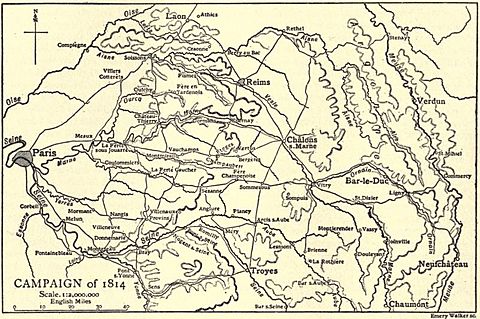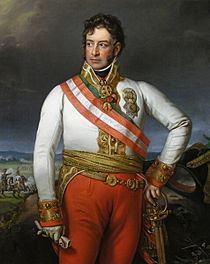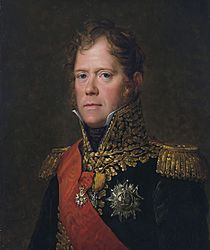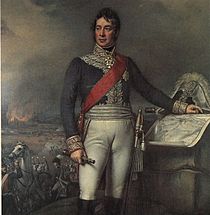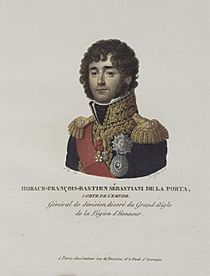Battle of Arcis-sur-Aube facts for kids
Quick facts for kids Battle of Arcis-sur-Aube |
|||||||
|---|---|---|---|---|---|---|---|
| Part of the Campaign of France of the Sixth Coalition | |||||||
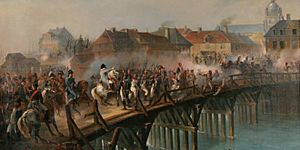 Napoleon at the bridge of Arcis-sur-Aube by Jean-Adolphe Beaucé |
|||||||
|
|||||||
| Belligerents | |||||||
| Commanders and leaders | |||||||
| Strength | |||||||
| 74,000–107,900 | Day 1: 18,000 Day 2: 28,000–30,000 |
||||||
| Casualties and losses | |||||||
| 3,000–4,000 | 3,000–4,200, 3 guns | ||||||
The Battle of Arcis-sur-Aube happened on March 20–21, 1814. It was a fight during the War of the Sixth Coalition. The French army, led by Napoleon, faced a much larger Allied army. This Allied force was under the command of Karl Philipp, Prince of Schwarzenberg.
On the second day, Napoleon realized his army was greatly outnumbered. He quickly ordered a secret retreat. By the time the Allied commander, Schwarzenberg, understood what was happening, most of the French had already left. The Allies tried to chase them, but couldn't stop the French army from getting away safely. This battle was one of Napoleon's last big fights before he gave up his power and went into exile.
While Napoleon was fighting a different Allied army in the north, Schwarzenberg's army pushed the French back towards Paris. After winning a battle at Reims, Napoleon moved south. He wanted to threaten Schwarzenberg's supply lines. In response, Schwarzenberg pulled his army back to Troyes and Arcis-sur-Aube. When Napoleon took control of Arcis, Schwarzenberg decided to fight instead of retreating further.
The first day's fighting was not clear. Napoleon thought he was chasing a retreating enemy. On the second day, the French moved to higher ground. They were surprised to see between 74,000 and 100,000 enemy soldiers ready for battle. After tough fighting, with Napoleon himself joining in, the French managed to escape. However, it was a setback for Napoleon's army.
| Top - 0-9 A B C D E F G H I J K L M N O P Q R S T U V W X Y Z |
Background to the Battle
Napoleon's Campaigns in France
In early 1814, Napoleon found out that the Allied armies had split up. One Allied army, led by Gebhard Leberecht von Blücher, was heading towards Paris. Blücher had 53,000 soldiers. Only 10,000 French soldiers stood in his way.
Napoleon left 42,000 troops to hold back Schwarzenberg's main army. He then took 35,000 soldiers and moved northwest. His goal was to deal with Blücher's army. The French stopped Blücher in a battle on February 28. But Napoleon couldn't trap Blücher, who managed to escape.
Napoleon then planned to push Blücher far north. After that, he wanted to gather more French soldiers from garrisons. Finally, he would attack Schwarzenberg's supply lines.
Fighting in the North
As Napoleon's army chased Blücher's army north, the Allies got many more soldiers. Blücher's army grew to 110,000 men. On March 7, Napoleon fought the Russians in the Battle of Craonne. This was a very costly victory for the French.
On March 9–10, Blücher defeated Napoleon's smaller army at the Battle of Laon. Napoleon's army was beaten, but he tricked the Allies into not chasing them. On March 12, Allied troops captured Reims from the French. Napoleon quickly marched his army there. He won the Battle of Reims the next day. The Allied commander was badly hurt, and his troops lost many men and guns.
Napoleon Moves South
Napoleon rested his troops at Reims for three days. Meanwhile, Marshal Michel Ney took back Châlons-sur-Marne. Ney also got 3,000 new soldiers. Napoleon wanted to move east to gather more troops. But Schwarzenberg's army was attacking in the south. So, Napoleon had to march in that direction instead.
While Napoleon was fighting Blücher in the north, the main Allied army pushed the French back. On February 27, Schwarzenberg defeated a French force. This made the French army retreat further west. The Allies then defeated the French again on March 3–4. Schwarzenberg took over Troyes. But he stopped there until March 12, unsure what to do.
When he heard about Blücher's victory at Laon, Schwarzenberg felt braver. His main Allied army crossed the Seine River. They pushed the French back by March 16. But Schwarzenberg's attack stopped suddenly when he heard about Napoleon's win at Reims.
Napoleon decided to move against Schwarzenberg with 24,000 soldiers. He also had more troops coming. He planned to march towards Arcis-sur-Aube. He hoped to get behind the main Allied army at Troyes. On March 17, Schwarzenberg pulled his army back. They moved to the area between Troyes and Arcis.
The next day, Napoleon's advance troops pushed Schwarzenberg's cavalry south. This caused alarm among the Allied leaders. A Bavarian army corps was told to hold Arcis. This would give the rest of Schwarzenberg's army time to retreat east. On the afternoon of March 19, the French began to cross the Aube River. French cavalry moved east along the south bank of the Aube.
Schwarzenberg thought Napoleon was moving towards Troyes. He believed his supply lines were safe. So, on the evening of March 19, he decided to gather his army. He planned to attack the French. He ordered his troops to move between Troyes and Arcis.
Napoleon believed Schwarzenberg was fully retreating east. To speed up the Allied retreat, Napoleon decided to move east. He planned to attack Arcis from both sides of the Aube River. After pushing the Allies, Napoleon planned to cross another river. He would then gather more French troops from eastern garrisons. Napoleon thought he would add 50,000 more soldiers to his army. Napoleon's plan was good until Schwarzenberg decided to attack on March 19.
The Battle of Arcis-sur-Aube
Day One: March 20
On March 20, Schwarzenberg ordered his troops to take positions. He planned to start a westward attack at 11:00 AM. He thought Napoleon was moving across his path. Schwarzenberg hoped to hit the French army from the side. However, Napoleon was moving east, not south. This messed up all of Schwarzenberg's plans.
Early in the morning, French cavalry moved east. At 10:00 AM, the French took Arcis-sur-Aube. The Bavarians had left the town. Local people warned the French that large Allied forces were nearby. But Napoleon refused to believe it. The French quickly fixed the bridge over the Aube River.
At 1:00 PM, Napoleon arrived and met with Marshal Ney. Napoleon was still sure the Allies were retreating. He believed there were only about 1,000 enemy soldiers nearby. Schwarzenberg finally gave the order to attack at 2:00 PM. Allied infantry moved towards a French position. A large group of Allied cavalry moved to fight the French horsemen.
The Allied cavalry attacked the French cavalry. The first French line was defeated. Then the second line was also beaten. Many French cavalry soldiers ran towards the Arcis bridge. Napoleon bravely rode into their path, drawing his sword. He shouted, "See who will re-cross the bridge before me!"
At the same time, the skilled soldiers of the Old Guard began crossing the bridge. They took up positions to defend Arcis. The French cavalry slowly started to get back in order. During this tense moment, an Allied cannon shell landed near the troops. Seeing his soldiers flinch, Napoleon rode his horse directly over the bomb. The shell exploded, killing his horse and knocking Napoleon down. But Napoleon quickly got up, unharmed. He got on a new horse and rode off to check on his army.
The Allies sent more cavalry and attacked a French position. They hoped to capture the Arcis bridge. The Allies broke into the village but were pushed back by the French. The French had to recapture the village several times. The Old Guard, Napoleon's best soldiers, helped push the Allies out. Between 5:00 PM and 8:00 PM, the French fought off many Allied attacks. One Allied regiment lost 500 soldiers in the tough fighting.
Later that evening, a new French cavalry division arrived in Arcis. Another 4,500 new soldiers stopped nearby to rest. The French cavalry had been fighting the Allied cavalry all day. The French decided to launch a night attack. They hoped to silence an Allied cannon battery. The French charge was "magnificent." It broke through the Allied cavalry and pushed back some Austrian troops. Even the tired French cavalry, who had been beaten earlier, joined the attack.
A group of Russian soldiers formed a square and stopped the French cavalry. Allied cavalry from different countries then attacked the French. The French were forced to pull back, but they did so in an orderly way. The fighting ended with a village between the two armies.
Day Two: March 21
On the first day, the Allies probably lost 2,000 soldiers. The French lost a bit fewer. Even though the Allies had many more soldiers, they didn't gain any ground. If Napoleon had known how many enemies he faced, he would have retreated during the night.
In fact, the Russian Tsar feared Napoleon would retreat and then attack the Allied supply lines. But Napoleon still thought the Allied army was retreating. It took a long time for the Allied troops to get into position on March 21.
Historians say the Allies had about 74,000 to 80,000 soldiers ready to fight. Napoleon faced them with only 28,000 to 30,000 French soldiers. On the second day, Napoleon's army was much smaller than the Allies.
Napoleon was waiting for more soldiers to arrive. More Young Guard troops reached Arcis. Other French army corps also arrived. But many French troops were still a day's march away. Napoleon sent out patrols to the east. They didn't find anything unusual because the Allies had pulled back. At 10:00 AM, Napoleon ordered his army to attack.
As the French troops reached the top of a plateau, they saw a huge enemy army. There were perhaps 100,000 enemies lined up in three rows. They stretched from the Aube River to a nearby stream. In front of them were many skirmishers and at least 100 cannons. The French cavalry immediately attacked the Allied cavalry. They pushed them back to the second line.
The French position was very dangerous. The village of Torcy-le-Grand was empty, and Arcis was not well defended. If Schwarzenberg had attacked with all his forces then, the French army would have been destroyed. Instead, the Allied commander held a meeting with his officers. This meeting lasted until noon. They decided to attack, but Schwarzenberg would give the signal.
The French cavalry attack made Schwarzenberg think Napoleon was getting ready to advance. But by 1:00 PM, Napoleon finally realized he was greatly outnumbered. He knew he needed to get his army out of danger. The French began to pull back their divisions. Orders quickly came from Napoleon's headquarters.
By 1:30 PM, a bridge made of boats was built west of Arcis. Soon after, the Old Guard and artillery were told to retreat using this new bridge. Other cavalry corps also joined the retreat. The French cavalry was ordered to cover the retreat. They did this by slowly pulling back. To keep the Allies from stopping the retreat, Napoleon ordered a French division to defend Arcis. These were tough soldiers who had fought in Spain.
At 3:00 PM, Schwarzenberg finally understood that Napoleon was retreating. Instead of attacking right away, he called another meeting. Allied troops were ordered to cross the Aube River. Only the cavalry managed to cross easily. The infantry had to march further upstream to cross. Other Allied corps were told to attack Arcis. Meanwhile, more Allied cavalry and infantry also moved forward. During this advance, the Allied cavalry claimed to capture a French cavalry group and three cannons. By 4:00 PM, the Allies were near Arcis. They started firing 80 cannons at the town.
Under this heavy attack, the French cavalry pulled back across the boat bridge and destroyed it. The French infantry defended Arcis. The Allies attacked Arcis, and the fighting was intense. The French fought back hard. One French regiment pushed back an initial attack. But the Allies soon forced their way into Arcis. The French commander was wounded. With the defense almost broken, a French officer rallied 100 soldiers. This allowed the last few troops to get onto the bridge and escape safely at 6:00 PM. The French destroyed the bridge after they crossed.
Conclusion
That evening, the French troops blocked the road on the north side of the Aube River. Other French army corps arrived nearby. Luckily for the French, the Allies did not try to cross the river. They did not try to attack the spread-out French forces. The rest of Napoleon's army headed north.
Napoleon still planned to march east and attack the Allied supply lines. All day on March 22, French troops blocked the bridge at Arcis. This meant the Allies had no idea where Napoleon's army was going.
Historians say the French lost about 3,000 to 4,200 soldiers and three cannons. The Allies lost about 3,000 to 4,000 soldiers. The French soldiers fought very well. On the first day, about 7,000 French soldiers fought 22,000 Allied soldiers to a standstill.
On March 25, the Allies defeated more French forces. Napoleon won a battle on March 26, but it didn't help him much. The Battle of Paris was fought on March 30. The Allies took over the French capital the next day. Napoleon gave up his power on April 6, 1814.
Forces Involved
Allied Army Order of Battle
| Army corps | Infantry strength | Cavalry strength | Corps/division |
|---|---|---|---|
| III Corps Feldzeugmeister Ignaz Gyulai |
10,800 | 3,200 | Austrian Division: Feldmarschall-Leutnant Louis Charles Folliot de Crenneville |
| Austrian Division: Feldmarschall-Leutnant Jean Charles Hennequin de Fresnel | |||
| Austrian Cavalry Division: Feldmarschall-Leutnant Johann Nepomuk von Nostitz-Rieneck | |||
| IV Corps Crown Prince William of Württemberg |
10,200 | 3,600 | Württemberg Division: General-Leutnant Prince Adam of Württemberg |
| Württemberg Division: General-Leutnant Friedrich von Franquemont | |||
| 3rd Russian Cuirassier Division: General-Leutnant Ilya Mikhailovich Duka | |||
| V Corps General der Kavallerie Karl Philipp von Wrede |
22,100 | 4,800 | Austrian Division: Feldmarschall-Leutnant Anton Leonhard von Hardegg |
| Austrian Division: Feldmarschall-Leutnant Ignaz Splény de Miháldi | |||
| 1st Bavarian Division: General-Leutnant Joseph von Rechberg | |||
| 3rd Bavarian Division: General-Leutnant Peter de Lamotte | |||
| 1st Russian Grenadier Division: Generalmajor Pavel Nikolaevich Choglokov | |||
| VI Corps General-Leutnant Nikolay Raevsky |
16,500 | 3,500 | I Russian Infantry Corps: General-Leutnant Andrei Ivanovich Gorchakov |
| II Russian Infantry Corps: General-Leutnant Duke Eugen of Württemberg | |||
| Russian Cavalry Corps: General-Leutnant Peter Petrovich Pahlen | |||
| Reserve General Michael Andreas Barclay de Tolly |
3,000 (8,000) | 1,600 | Austrian Grenadiers: Feldmarschall-Leutnant Nikolaus Weissenwolf |
| 2nd Russian Grenadier Division: Generalmajor Ivan Paskevich | |||
| 2nd Russian Cuirassier Division: General-Leutnant Nikolay Vasilyevich Kretov | |||
| 15,800 | 4,800 | Russian Guard Cavalry: General-Leutnant Mikhail Miloradovich | |
| Russian Guard Infantry: General-Leutnant Aleksey Petrovich Yermolov | |||
| Prussian Guard Cavalry: Generalmajor Friedrich von LaRoche-Starkenfels | |||
| Prussian Guard Infantry: Colonel Johann Friedrich von Alvensleben | |||
| 0 | 3,000 | Cossack Corps: Generalmajor Paisiy Sergeevich Kaisarov | |
| Cossack Corps: Generalmajor Alexander Nikitich Seslavin | |||
| Army totals | 83,400 | 24,500 |
French Army Order of Battle
| Commands | Strength | Division |
|---|---|---|
| Ney's command Marshal Michel Ney |
8,000 | 1st Old Guard Division: General of Division Louis Friant |
| Provisional Guard Division: General of Brigade Christophe Henrion | ||
| 5,500 | Infantry Division: General of Division Jan Willem Janssens | |
| 9th Infantry Division: General of Division Pierre François Xavier Boyer | ||
| Sebastiani's command General of Division Horace Sebastiani |
7,300 | 1st Guard Cavalry Division: General of Division Pierre David de Colbert-Chabanais |
| 2nd Guard Cavalry Division: General of Division Charles Lefebvre-Desnouettes | ||
| 3rd Guard Cavalry Division: General of Brigade Louis-Michel Letort de Lorville | ||
| Honor Guards Cavalry Division: General of Division Jean-Marie Defrance | ||
| Cavalry Division: General of Division Remi Joseph Isidore Exelmans | ||
| Cavalry Division: General of Division Sigismond Frédéric de Berckheim | ||
| Oudinot's command Marshal Nicolas Oudinot |
2,500 | II Cavalry Corps – Division: General of Division Antoine Louis Decrest de Saint-Germain |
| II Cavalry Corps – Division: General of Division Antoine Maurin | ||
| 6,500 | VII Corps – 7th Infantry Division: General of Division Jean François Leval | |
| Army total | 29,800 |


